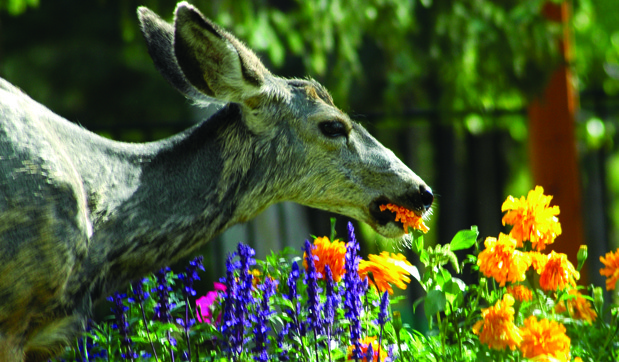Solutions to Invermere’s ongoing human-deer conflict are headed to the council table, and could be up for debate before the end of the month.
The district’s Urban Deer Committee is recommending a two-pronged approach to managing the animals that includes both relocation and culling programs, according to a report submitted to the district.
While the deer issue was on the agenda for the district’s July 12 meeting, council pushed back their debate after learning members of the deer committee hadn’t seen the final draft of their report. The issue will now likely be dealt with at a special meeting some time this month.
If recommendations are followed, some district deer will be trapped and relocated to the Upper Kootenay River Valley, a site offered to the district by the provincial Ministry of Environment. Others would be captured and put down.
In the meantime, the district would also start a major educational initiative that would inform residents of the deer issues and “offer non-lethal options to land owners to discourage deer or reduce incidents, such as appropriate landscaping and the use of fencing.”
According to the report, both moving and killing the deer have their downsides, and some similarities.
Even if the district opted for a relocation-only program, “capture, handling, transport and release in unfamiliar territory can result in moderate to high rates of injury and mortality,” the report notes. The option may be more expensive long term, and there’s also the risk city-slicker deer may simply move back into the nearest urban community once they’ve been deposited in the wild.
A cull, meanwhile, “may generate public complaints” and could have steep startup costs if the district purchases its own traps and bolt guns.
Processing the deer may also be expensive (the committee is recommending the district see if local food banks will accept some deer meat, and talk to the province about cost sharing).
In addition to the recommended solutions the committee also researched several other options, including allowing public hunting in the district, sharpshooting, fertility control and community fencing.
Under the plan, the province would take the lead on deer management, with the district acting as a partner. Culling would begin this fall, while relocation would kick into gear next spring. According to the report, the district’s deer population could be reduced by 75 per cent by 2016.
Deer by the Numbers
18 — the number of deer per sq/km in Invermere, according to a February 2011 deer count put on by volunteers
75 — the percentage of respondents to a committee survey who would like to see at least a 30 per cent decrease in the deer population; also the percentage the district’s deer population could be reduced by in 2016
$15,000 — the amount budgeted by the city of Helena, Montana to cull at least 25 deer (with the option to remove up to 50, weather depending) in 2010-11
source — Urban Deer Committee
Final Report and Recommendations
